In-Depth Guide: Choosing a Healthy Mattress | Slow Rolling Home Journey
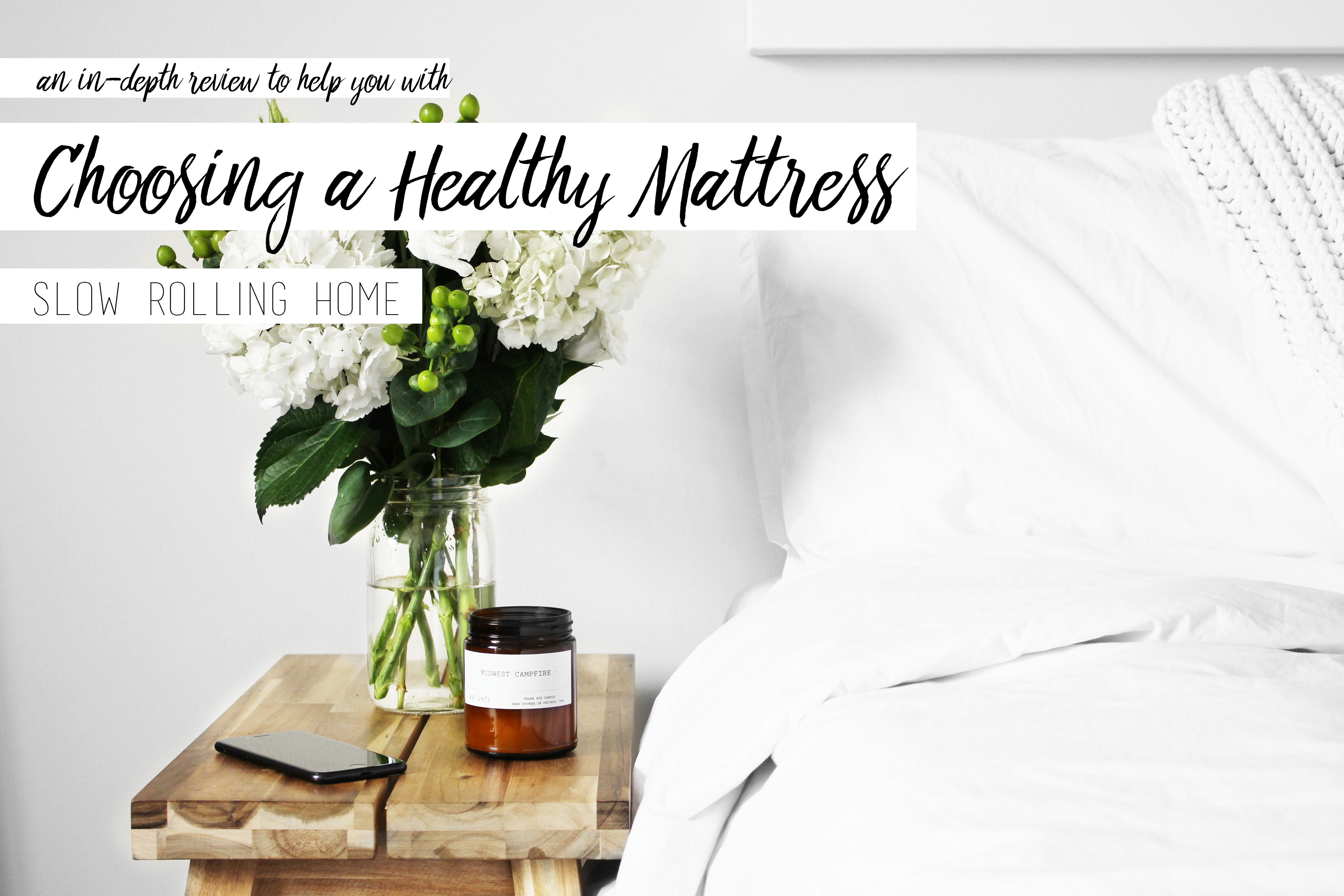
photo by Logan Nolin
Buying a mattress is harder considerably than buying a car, a piece of technology; I’d argue it’s harder than buying anything. It’s hard because you can’t test-drive it in its natural state, depending on where you live there may be limited access to ANY options, and the options vary so widely that it’s hard to find a middle ground on which to base your judgment.
Concerns about bedding materials and the seemingly unhealthy nature of mainstream mattress options is finally breaking into the mainstream. However, this means that in the sea of healthy mattress options available, you’re playing a guessing game on the Internet with the hopes that the first one you pick it the right one.
We decided that being faced with the daunting undertaking of purchasing a new, healthy mattress, we’d do as much research as we could about what we were getting ourselves into. We dug deep into our sleeping habits. We asked questions about chemicals we never thought would be so close to us. We even made the silly choice in asking for samples, which only resulted in feeling confused by this spongy square of material and feeling a bit sad for all the packaging that wasted in its delivery.
In choosing a mattress for a small space, we’re aware that the impacts chemical off-gassing might be more intense than in a regular house. Spring mattresses have their own problems, but as two foam-fiends, our researched focused on memory foam beds and their available healthier counterparts. Here’s a list from Sleep Junkie of all the concerning chemicals that go into memory foam mattresses alone: Source
- Polyols – the binder/bulk ingredient. Usually composed of petroleum oil-derived ingredients, but may also include botanical sources like soy or castor beans.
- Diisocyanates – the reactive ingredient. Reacts with the polyols and blowing agent to produce a flexible polyurethane foam. The most commonly used sources are MDI and TDI, which alone in raw forms can cause respiratory and dermal sensitization and may be carcinogenic. MDI is regarded as the safer and less toxic option and is known to be the least hazardous organic isocyanate. The primary hazard with these compounds is during manufacturing; after reacting they are inert but can offgas.
- Blowing Agents – introduces carbon to create the foam. Used to use CFCs, though today manufacturers may use water, HFC or other agents.
- Methylene dianiline / MDA – suspected carcinogen, eye, and skin irritant, liver and thyroid damage with ingestion. Household products produce very low levels, the greatest risk is during manufacturing.
- Vinilideine chloride – eye and respiratory irritation, a possible carcinogen, organ damage. Primary hazard is during manufacturing.
- Methyl benzene – inhalation can affect the nervous system.
- Dimethylformamide – organ damage possible, and possible carcinogen, though the primary risk is during manufacturing.
- Acetone – toxic when inhaled in large amounts, but limited effects with low exposure.
- Methylene chloride – a solvent, mucous membrane irritant and potential carcinogen. Use has declined in recent years due to EU restrictions and pollution regulations.
- Formaldehyde – typically not added to foams, but may result as a byproduct of chemical reactions or adhesives.
GROSS.
While researching bedding and bedding companies, we came across some propaganda-seeming “research” touting that the company’s mattress wasn’t as gross as their competitors but also claiming that a chemical-free mattress doesn’t exist. If you want to split hairs and say that everything is essentially made of chemicals, that argument holds weight. But in the sense we’re covering here, there definitely are harmful chemical-free mattresses on the market that outperform their conventional counterparts in every qualification.
Plenty of healthy options definitely exist in the mattress market, but choosing one that fits all of your personal expectations takes more research than simply dropping in at your neighborhood Mattress Firm. You may learn a bit about bed technology and mattress materials (and a lot of marketing propaganda), but the truth is that the negative health effects of spending a third of your life on a flame retardant Petrie dish isn’t widely recognized by the people whose livelihoods depend on you buying those Petrie dishes.
We’ve done copious amounts of research on available healthy options for bedding and have curated a selection of our personal standards, our constraints for our space, and our budget. It’s unavoidable that these more health-forward products be more expensive than their conventional alternatives. My justification is that you spend a third of your life on your mattress - you should choose the best you possibly can.
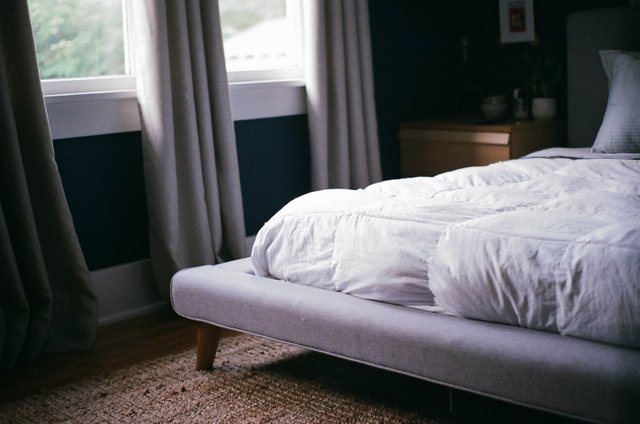
photo by Ty Carlson
Non-toxic Mattress Materials
There are plenty of unique and interesting bedding combinations available but it seemed that these top three were the most popular in mainstream non-toxic mattresses: Source
- Cotton: Cotton is often found in lighter-weight mattresses like futons or combined with an inner spring. Cotton is hypoallergenic, but not as resistant to dust mites as other mattress materials.
- Wool: Naturally mould and mildew resistant, wool wicks away moisture and keeps sleepers at a comfortable temperature. One small study at the University of Sydney in Australia found that sleep quality improved with wool versus cotton or synthetics. Wool is also naturally flame resistant, so wool mattresses don’t need additional flame-retardant treatment. Though wool is considered hypoallergenic, those with sensitivity to lanolin should probably steer clear.
- Latex: Natural latex mattresses offer some pretty appealing benefits as long as you don’t have a latex allergy. Some are even certified organic. Latex mattresses retain their shape really well, so the compression that can happen over time with other materials is less of an issue. Some latex beds are guaranteed for 20 years or more. They’re also known for limiting the amount of vibration you feel when someone on the other side of bed moves or twitches.
How cool is it that wool, a natural ingredient that can be harvested without harming the animal from which it grows, is naturally flame-retardant and therefore doesn’t require additional chemicals? It makes me wonder why we use chemicals in the first place! With this in mind, these are the materials we’ll be looking for in our future mattress.
We thought we were done knowing these three ingredients… but there’s more! Latex comes in two distinctly different varieties: Dunlop and Talalay. Source
Talalay is the softer of the two, and gives more of a ‘cloud-like’ feel. It is also traditionally more expensive. To balance these two facts, we give one free talalay layer with all mattresses and do our best to keep your cost for adding additional talalay layers as low as possible.
100% dunlop latex mattresses are the only latex beds that can be certified organic because the talalay manufacturing process uses ammonia and is not congruent with GOLS standards. Dunlop also comes in a 100% natural option. All other factors being equal, dunlop is more firm and supportive than talalay. This is offset by dunlop being a bit more durable. That’s why we generally recommend dunlop for the bottom support layers of your latex mattress.
This is great to know, but then, what is GOLS standards? We learned that there are a whole slew of certifications and designations that determine to what degree of ‘naturalness’ that a mattress is made. Source
- GOLS: stands for the Global Organic Latex Standard. GOLS sets the standard for organic latex worldwide, determining which latex is actually organic and which is not.
- GOTS: the Global Organic Textile Standard. Much like GOLS, it’s a leading standard worldwide but instead of for latex, GOTS is for textiles like cotton.
- OEKO-TEK: Also known as confidence in textiles, OEKO-TEK is an independent label for various textiles.
- LGA: global certifying agency who preforms tests for chemicals, toxicity, carbon foot print, water foot print and product life cycle assessments.
- Oregon Tilth: a United States organization who certifies sustainability in the marketplace. They help shape public policy towards more organic principals and practices.
- Eco-Institute: Originally a European certification, Eco-Institute’s services include manufacturing emissions testing and analyzing heavy metals, biocides, phthalates, fire retardants and more.
These in-depth details come from Sleeping Organic LLC, a manufacturer of organic mattresses and bedding. This level of detail and certification right on a product page built a lot of trust with us as consumers and gives me reason to believe they may be a major contender in our bedding choices.
Sleeping Organic’s product page is also an in-depth mattress personalization form. This made me think: Have I ever actually analyzed how we sleep?
How we sleep
- We’re different temperature sleepers: Alhen tends to “sleep cold”, meaning he can stay cool under covers, whereas I “sleep hot” and am often tossing blankets off various extremities throughout the night.
- Neither of us are very restless sleepers (unless we are uncomfortable), but both agree that we turn over occasionally.
- We both prefer a medium-squishy mattress and prefer a foam-support feel rather than a springs-forward feel.
- Surprisingly, we are both single-pillow users that prefer a medium-thin head support with a between-the-knees pillow, with both of us ending up primarily sleeping on one side.
Taking everything we learned into consideration, we drafted our own standards to guide us in choosing our mattress.
Our mattress standards
- To be free of harmful chemicals and yucky springs
- For our mattress to contain in some-fashion: wool, latex, organic cotton
- Warranty + customer service: While we don’t have much experience with warranties on large purchases like this, we want to be sure that if something goes wrong with our bed or we have questions down-the-road (literally), we know that we have a caring company who is committed to quality and their customers.
- Manufactured ethically with sustainably harvested/produced materials
- Sizes available: Choosing a smaller bed was a tough decision but we’re committed to a Full Size mattress that is thinner than 10 in (so that we don’t bang our heads when we sit up!)
- Delivery options: We’re a bit remote and will need our bed delivered to us, preferably packaged such that we can get it through the doors of our bus! Free shipping is a nice bonus!
- Financing available would be a nice option, so we could pay off our bed in a few payments rather than a big chunk all at once

When it comes to budget, I’ll admit we didn’t have a specific number in mind when setting out to buy a mattress. We’re still young and haven’t gone through this process nearly enough to have an informed opinion of what this type of endeavor “should” cost or to be in the position of compromising our standards for price. So, for our bedding and linens (which include sheets, towels, and any other house linens) combined, we’ve elected to spend less than $2500. Over a 5-year period, that’s well worth living chemical-free!
The Contenders
Without further ado, here are the mattresses we are comparing before making our big investment in better sleep!
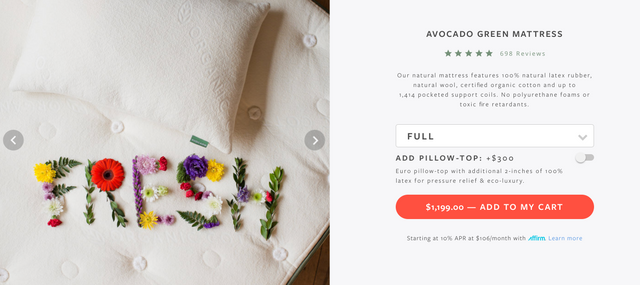
Avocado Bed
- Materials: Natural latex, wool, organic cotton.
- Warranty: 100-night trial + 25-year limited warranty.
- Manufacturing Details: Handmade in the USA.
- Size: Full at 11" thick - This is above our limit but we are still considering this bed!
- Delivery Options: Free shipping + returns.
- Price: $1,199 + tax.
- Financing Available: Yes, at 10% APR provided by Affirm.
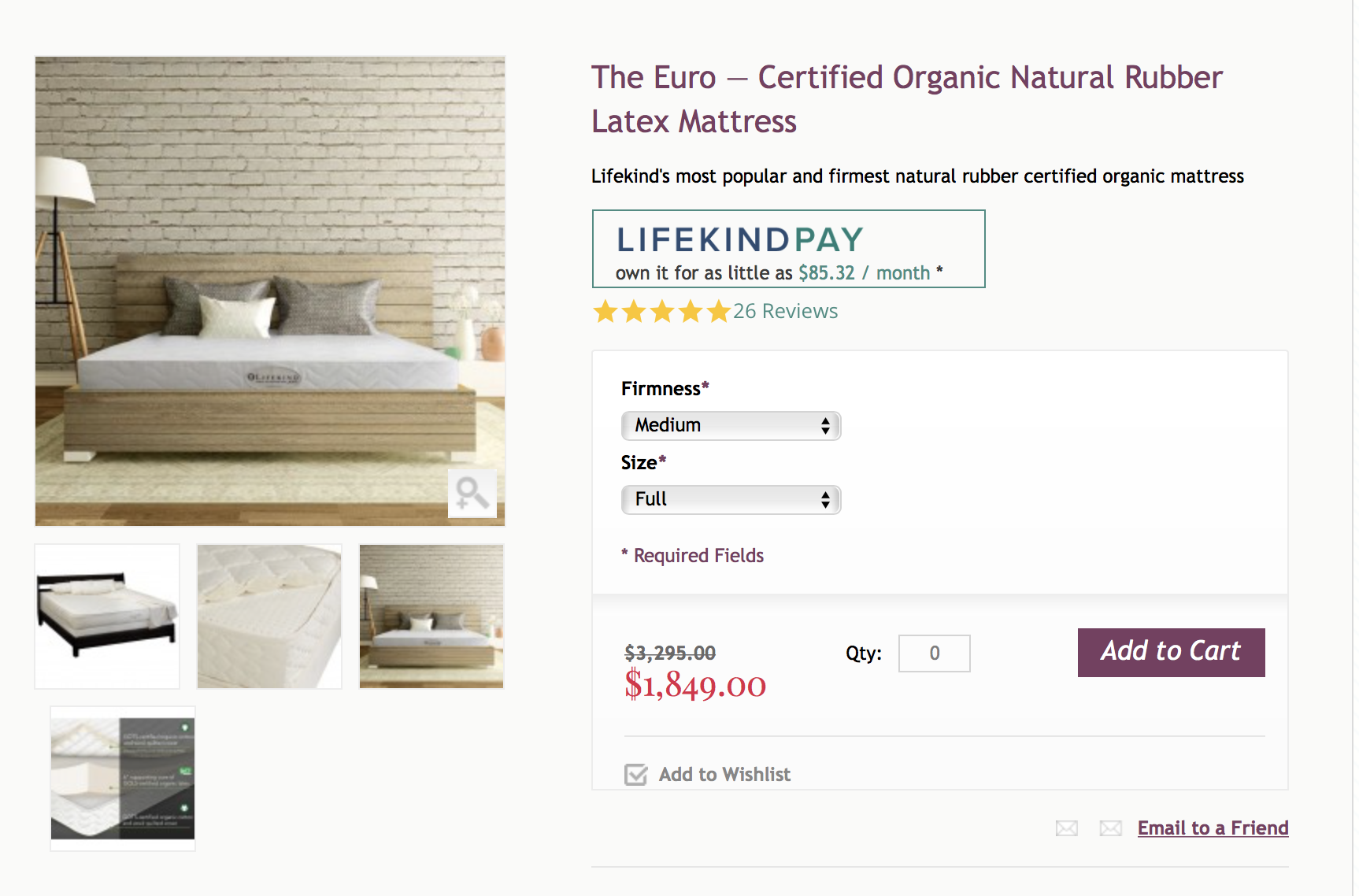
LifeKind
- Materials: Natural Latex, Organic Cotton, Organic Wool
- Warranty: 90-day "Comfort Exchange" + 20-year Limited Warranty. You must sleep on it a minimum of 15 nights.
- Manufacturing Details: Made in the USA.
- Size: Full at 7" thick.
- Delivery Options: Free shipping.
- Price: $1,849 + tax, on sale for MLK Day 2018
- Financing Available: Yes, through their internally-managed LifeKind Pay.
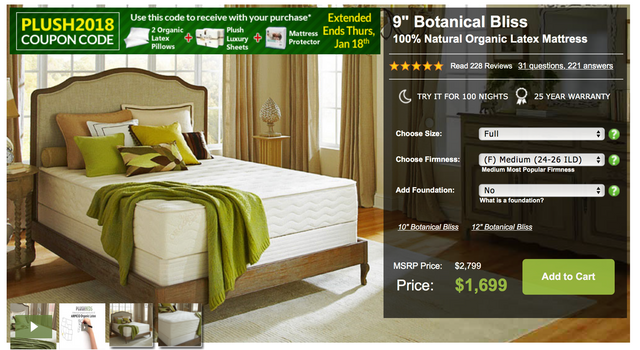
Plush Bed
- Materials: ARPICO Latex, Talalay Latex, Organic Cotton, Organic Wool
- Warranty: 100 days + 25 year warranty.
- Manufacturing Details: They claim "American Made Luxury" but I can't verify their manufacturing practices.
- Size: Full, 10" thick.
- Delivery Options: Free delivery via UPS.
- Price: $1,699, tax-free while currently on sale (MLK Day 2018)
- Financing Available: By PayPal 'Bill Me Later.'
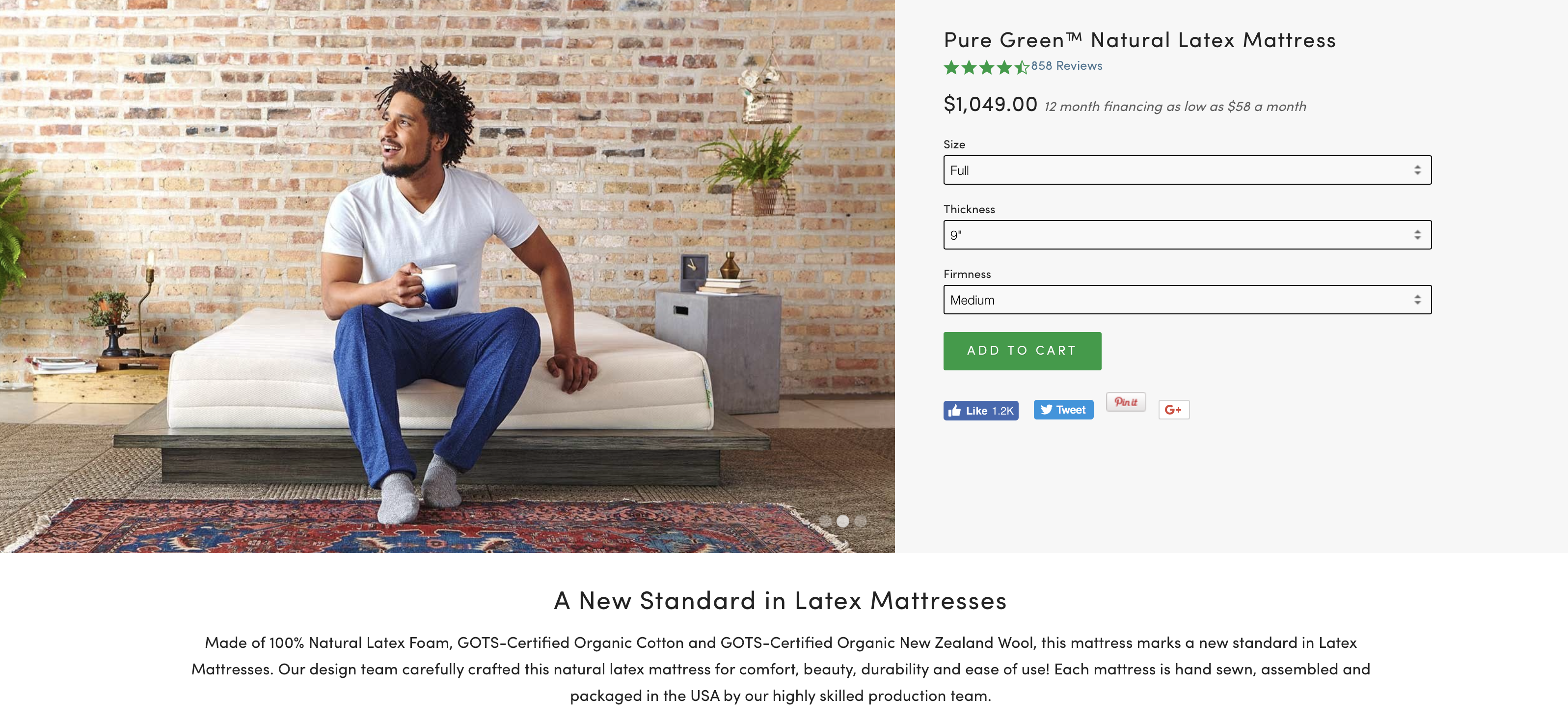
Sleep on Latex
- Materials: Dunlop Latex, Organic Cotton, Organic Wool
- Warranty: 100 days + 10 years limited warranty.
- Manufacturing Details: Made in Chicago, USA.
- Size: Full, 7" or 9" thick.
- Delivery Options: Free shipping.
- Price: $1,049 + Tax
- Financing Available: 12-month financing through Affirm.
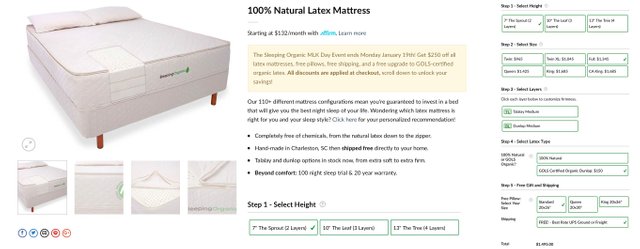
Sleeping Organic
- Materials: Talalay Latex, Dunlop Latex, Organic Wool, Organic Cotton
- Warranty: 100 night sleep trial + 20 year warranty
- Manufacturing Details: Made in the USA, Charleston SC
- Size: Full, 7" thick.
- Delivery Options: Free shipping to residential address.
- Price: $1,495 + Tax, includes a free pillow!
- Financing Available: Provided by Affirm.
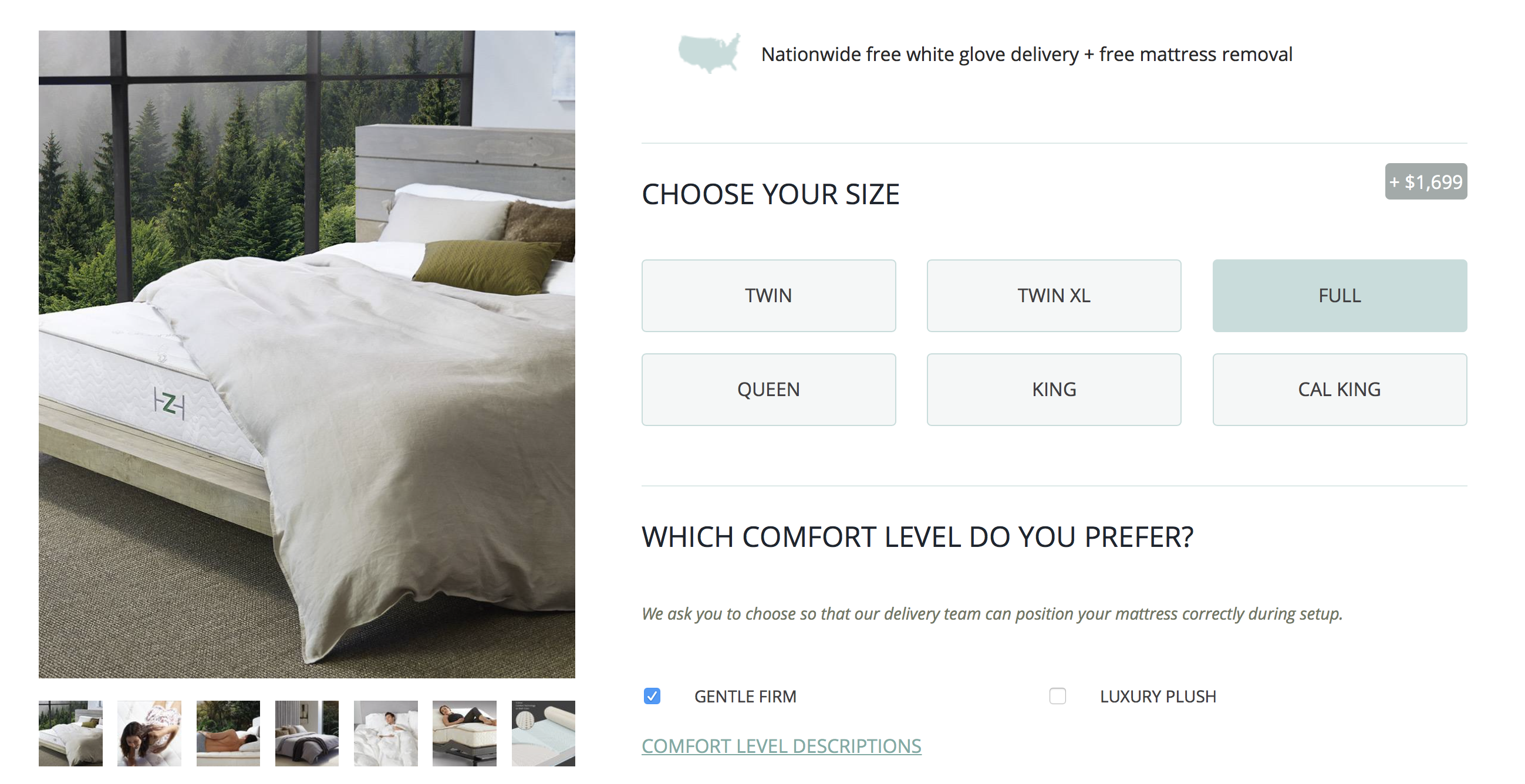
Zenhaven, by Saatva
- Materials: Talalay Latex, Organic Wool, Organic Cotton - bonus: mattress is flippable
- Warranty: 120 in-home trial, 100% money back guarantee,
- Manufacturing Details: Made in the USA
- Size: Full at 10" thick.
- Delivery Options: Free 'white glove' delivery, home setup, and mattress removal.
- Price: $1,699 + Tax
- Financing Available: Provided by PayPal Credit.
Deliberation begins!
Armed with this multitude of information, we're going to dig into reviews, contact a couple companies for more information on their manufacturing practices, and take YOUR SUGGESTIONS into account!
Do you have experience choosing or sleeping on a non-toxic mattress?
We'd love if you shared your experience with us in the comments below. Feel free to ask any questions that may not have been covered in the article. And, keep an eye out for my upcoming article on Natural & Non-toxic Linens for bedding and home use.

Hi, I'm Amelia! It's nice to meet you.
To learn more about me, check out my introduction post, get up-to-date on my school bus tiny house conversion, and follow me for articles on slow living, sustainable fashion, self-expression, and quality curated resteems!

You have done a great research, I never knew there were so many different mattress available and especially the health facts. Appreciate your effort. Looking forward for your article on linens for bedding & home.
Wow! In-depth was an understatement. You certainly did a ton of research for this, I wish I would've even thought to consider researching or caring about this when I bought my new mattress less than a year ago. I honestly never thought about it and I have a really chemical free home. You have definitely given me something to think about, that's for sure.
I hope you were able to pull some value from it! I couldn't have anticipated the rabbit hole I jumped into when I decided I wanted a thorough understanding of nontoxic bedding. 😳 What this did for me, though, is help me to fully commit to the investment it's going to require when we do purchase our mattress. It's hard to justify a purchase that expensive but with this amount of knowledge, I'm more confident than EVER.
I did indeed! It is hard not to to be honest this was such a wonderful post. I wouldn't be surprised if my mattress is at least a bit toxic but at least I will have all this information that you delicately laid out for us when I go to buy one again. Thanks for putting in all the time and effort for not only hours of research but the time it spent to make this post as well, it saves others so much of theirs. Fantastic!
omg I never though about this before. But now I wont have to think since you did all the possible thinking and research about the subject and you're right :
@hazem91 Thank you for the compliment. It's crazy to think about how much time we actually spend on our mattresses. And what are we doing? Breathing. 😂 Best be breathing the cleanest air!
yeah sure 😂😂😂
Wow! This was totally new information for me. Awsome research. I can't belive how much time I actually spend on my mattress and apparently not a very good one 😜 lol
I absolutely gonna think about this and change my life 😉 I want healthy sleep and fresh air!
Then of course I know it only works if I actually go to bed and sleep 😁😁hahaha
Thank you for sharing this my friend and it was some great reading. Cheers!
Wow I have just come to realize I know nothing about mattresses
You sure gave us such a wealth of information and I will look forward to future posts and your selection of choice
This is fantastic!! Thank you!! Resteemed.
I've been researching this myself and only found two good mattresses...
https://www.holylamborganics.com/collections/organic-mattresses/products/wool-mattress
AND
https://openyoureyesbedding.com/collections/frontpage/products/new-twist-modular-pod-size
Great research, and i completely agree. I spent more time choosing my mattress then the car 😂
Saved for further use - NO IDEA there are so many to know about matresses wow !!! Cute smile ;)
Thanks for sharing! I feel like sometimes, people forget that a good bed is an important factor for good sleep. For me, my mattress must be orthopedic. I can sleep very well as long as I feel comfortable and my back doesn't hurt. Also, an influential role has the bedding. They must be qualitative, light, and not cause allergy. My favorites are silk sheets, especially in the summer. They are very comfortable and beautiful. Plus, they are good for sensitive skin because they are non-irritable and lightweight.